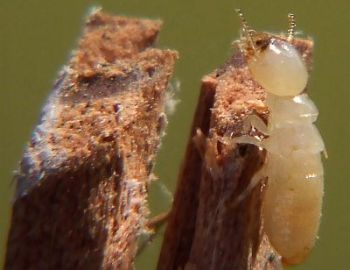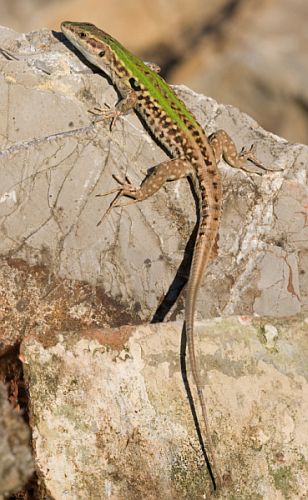Thinking biblically about termites and lizards
Eric R. from the UK writes in response to Termite mounds: cities in miniature. Comments from CMI’s Shaun Doyle are interspersed:

Dear Eric,
Thank you for your email. My comments are interspersed below.
Termites are indeed interesting ground dwelling social insects of which there are around 3000 species grouped into 7 or so families. My question is how did Noah manage to collect samples of each of these species, particularly those from USA, Australia, South America and Asia?
He didn’t have to. Termites, like other insects, didn’t need to be on the Ark—only land-dwelling vertebrates did (the Bible restricts it to land-dwelling creatures that breathed through ‘nostrils’—which only vertebrates have). Small, robust creatures such as termites could have survived in floating log mats, for example.
Nevertheless, Noah didn’t have to collect any animals for the ark—God brought them all to the Ark (Genesis 6:20).
Moreover, the continents were not necessarily in the same configuration before the Flood as they are today—the Flood was a global tectonic cataclysm that radically reshaped the Earth’s surface; far larger than any ‘catastrophe’ long-age geologists typically conceive of (see our Noah’s Flood Q and A page).
Another important point is that not every species of animal was brought to the Ark, but every kind of (land-dwelling vertebrate) animal was brought to the Ark. The Bible promotes a fixity of kinds, not a fixity of species in the modern sense. In modern taxonomic terms, a biblical kind (‘baramin’ is the technical term) typically ranges from anything from a genus to an order, though it often tends to settle around the level of family. See our Speciation and the Created Kinds Q and A page for more information.
I would also like to add that many of these species are recorded in the fossil record and therefore are known to have existed as separate species before the ‘time of the flood’.
The global Flood that the Bible records most likely produced the vast majority of the fossil record, including the earliest termite fossils. There would’ve been little fossilization before the Flood because the conditions needed for fossilization would’ve been extremely rare in comparison to the Flood. From this, we can indeed infer that termites existed as separate species before the Flood because the fossils provide some hints at termite diversity at the time of the Flood. This is not a problem for the Flood because the Flood would not have created a perfect ‘sediment/carcass soup’ in which everything was completely randomized. Rather, it is more consistent with a general fossil order (with many exceptions) in the rocks because different creatures in different environments would’ve been buried together in a general order ascending from the bottom of the sea to the tops of mountains (see e.g. The fossil record and Where are all the human fossils?). However, this also means that the fossil record does not provide a millions-of-years record of termite life and evolution. Therefore, citing the fossil record as evidence of a millions-of-years history of termites is fallacious because it assumes long-age chronology to disprove the Bible.
This may sound rather strange to you. People are not used to thinking biblically through these issues all the way. We are so used to associating e.g. dinosaurs with ‘millions of years ago’ and thinking that we evolved from ape-like ancestors that we rarely stop to think through these issues from assumption to conclusion. We need to ask questions like: how do we know the age of these fossils? How do we know the fossils present an evolutionary history, or even a succession of great ages? Is there a better way of looking at the fossil record?
What you’ve done in this comment is superimpose the Flood account on a long-age historical framework, it seems. It’s no wonder it doesn’t fit—the two contradict each other! I recommend you try operating consistently within the biblical framework to test it rather than superimposing it on assumptions that contradict it. In other words, try working with the assumption that Genesis history is true (even if just for the sake of argument). I think you’ll be surprised at just how much sense the Bible makes of the rocks and fossils if you do. Good places to start are our Geology Q and A page and the biblical geology site of CMI geologist Dr Tas Walker. He has developed a biblical model for understanding geology and has applied it to many field situations.
Interestingly, termites provide some problems for evolution, such as the matter of stasis and their marvellous biology, which speaks of purposeful design (see the related articles).
Regards,
Shaun Doyle
Creation Ministries International

Tomislav O. from the United States writes:
In the following article, carnivorous lizards are shown developing entirely new organs, within the span of roughly 30 years, with the function of digesting plants. If you didn’t know beforehand that this organ developed a mere 30-40 years ago, would you have shown it as something that is “irreducibly complex”? Doesn’t this falsify your claim that evolution can only work with existing information, and cannot create new information on its own?
CMI’s Dr Don Batten responds:
Dear Tom,
This link is not to the scientific paper, but it cites it (in PNAS). [http://www.sciencedaily.com/releases/2008/04/080417112433.htm]
[Edited August 2016] There was a good response here (with a live link to the PNAS paper): www.arn.org/blogs/index.php literature/2008/04/23/field_evidence_for_rapid_morphological_c but ARN.org seems to have since been restructured and the blogs removed.
Nevertheless, this was particularly pertinent in the blog (author not recorded at the time):
“The cecal valve finding is, however, dramatic. This is the finding that drew the comment that the animals ‘are evolving in ways that would normally take millions of years to play out’. There can be no rationale for a Darwinian mechanism here—involving incremental assembly of the cecal valve. There is no time for this, even if a gradualist route could be found. No, the relevant genetic information must be present in the ancestors and epigenetic factors can be inferred to have activated the relevant mechanisms to make the structure. This research is revealing that organisms have a capacity for variability that goes significantly beyond their current phenotype. This implication has not escaped the attention of creationist biologists, who find this research a vindication of their view that animal radiations are rapid and the expression of innate variability embedded in the genome. It would be an interesting and educational activity for students to evaluate this theoretical model alongside others—although we can already be confident that Darwinism would not fare well in the exercise.”
It is significant that the cecal valve is present in other herbivorous lizards in this family (Lacertidae), so it is not surprising that this particular species has the ability to produce cecal valves under certain conditions (it is quite possibly a facultative feature). Note that in the creation model the created kind here is likely represented by all the members of the family, or possibly even the order (that is, all genera in Lacertidae have derived from an original created kind, or baramin). You can find out more on our Speciation and Created Kinds Q and A page.
For evolutionists to use this as evidence for the sort of evolution that changed a microbe into me, they will first have to show that new genes have appeared, that were not already present in the population, which encode for the cecal valve. Indeed, the ScienceDaily article says, “Tail clips taken for DNA analysis confirmed that the Pod Mrcaru lizards were genetically identical to the source population on Pod Kopiste” (this was based on mitochrondrial DNA comparisons only, not the whole genomes, which would have to be compared to establish any genetic change that is behind the adaptation). It looks like a pre-designed adaptive ability.
Kind regards,
Don Batten


Readers’ comments
Comments are automatically closed 14 days after publication.